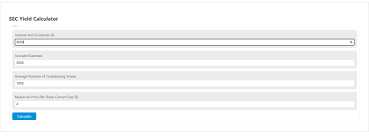2. 30-Day Yield Definition
The 30-day yield is a financial metric used to measure the annualized yield of an investment over a 30-day period. It is commonly used for money market funds and other short-term investments. The yield is expressed as a percentage and represents the income generated by the investment over a 30-day period.
What is Yield?
Yield is a financial term that refers to the return on investment (ROI) generated by an investment. It is typically expressed as a percentage and represents the income or profit earned from the investment.
Why is 30-Day Yield Important?

The 30-day yield is an important metric for investors because it provides a standardized way to compare the yield of different investments. By calculating the yield over a 30-day period, investors can easily compare the income generated by different investments, regardless of their duration or type.
Additionally, the 30-day yield allows investors to estimate the annualized yield of an investment. By annualizing the yield over a 30-day period, investors can project the potential income they can expect to earn over a year.
Calculation of 30-Day Yield:
The 30-day yield is calculated using the following formula:
30-Day Yield = (Income Earned / Net Asset Value) * (365 / Number of Days Held)
Where:
- Income Earned: The income generated by the investment over the 30-day period.
- Net Asset Value: The total value of the investment.
- Number of Days Held: The number of days the investment was held.
By plugging in the appropriate values into the formula, investors can calculate the 30-day yield of their investment.
Example:
Let’s say you have invested in a money market fund and earned $500 in income over a 30-day period. The net asset value of your investment is $10,000, and you held the investment for the entire 30-day period. Using the formula mentioned above, the calculation would be as follows:
30-Day Yield = ($500 / $10,000) * (365 / 30) = 0.05 * 12.17 = 0.6085 or 60.85%
Therefore, the 30-day yield of your investment is 60.85%.
The 30-Day Yield is a financial term that refers to the annualized yield of a mutual fund, exchange-traded fund (ETF), or any other investment vehicle that pays dividends or interest. It is a measure of the income generated by the investment over a 30-day period.
The 30-Day Yield is an important metric for investors as it provides them with an estimate of the income they can expect to receive from their investment on an annual basis. It allows investors to compare the income generated by different investment options and make informed decisions about where to allocate their funds.
To calculate the 30-Day Yield, the total income generated by the investment over a 30-day period is divided by the average net asset value (NAV) of the investment during that period. The result is then multiplied by 365 to annualize the yield.
4. 30-Day Yield Formula
The 30-Day Yield is a measure of the income generated by a mutual fund or exchange-traded fund (ETF) over a 30-day period. It is calculated by taking into account the dividends, interest, and other income earned by the fund, minus any expenses, and then dividing that by the average net asset value (NAV) of the fund over the same period.
Formula:
The formula for calculating the 30-Day Yield is as follows:
- Calculate the total income earned by the fund over the 30-day period. This includes dividends, interest, and any other income received.
- Subtract any expenses incurred by the fund during the same period.
- Divide the result by the average net asset value (NAV) of the fund over the 30-day period.
- Multiply the result by 365 to annualize the yield.
Mathematically, the formula can be expressed as:
Example:
Let’s say you have a mutual fund with a total income of $10,000 over a 30-day period. The expenses incurred by the fund during the same period amount to $1,000. The average net asset value (NAV) of the fund over the 30-day period is $100,000.
Using the formula, we can calculate the 30-Day Yield as follows:
30-Day Yield = ($9,000 / $100,000) * 365
30-Day Yield = 0.09 * 365
30-Day Yield = 32.85%
Therefore, the 30-Day Yield for this mutual fund is 32.85%.
The 30-Day Yield is a useful metric for investors to evaluate the income potential of a mutual fund or ETF over a 30-day period. It provides a standardized way to compare different funds and make informed investment decisions.
Calculating the 30-Day Yield
Calculating the 30-Day Yield is an important step in determining the performance of a mutual fund or an investment portfolio. It provides investors with a measure of the income generated by the fund over a 30-day period, expressed as a percentage of the fund’s net asset value (NAV).
To calculate the 30-Day Yield, you need to follow a simple formula:
- Start by determining the dividends or interest income earned by the fund over the past 30 days.
- Add any capital gains distributions made by the fund during the same period.
- Divide the total income by the fund’s average net asset value (NAV) over the past 30 days.
- Multiply the result by 365 (to annualize the yield).
- Finally, express the yield as a percentage by multiplying the result by 100.
Here’s an example to illustrate the calculation:
Let’s say you have a mutual fund with an average NAV of $10,000 over the past 30 days. During that period, the fund earned $100 in dividends and $50 in capital gains distributions. Using the formula mentioned above:
- Total income = $100 + $50 = $150
- 30-Day Yield = ($150 / $10,000) * 365 * 100 = 5.475%
Therefore, the 30-Day Yield for this mutual fund would be 5.475%.
Calculating the 30-Day Yield allows investors to compare the income generated by different funds and make informed investment decisions. It is important to note that the 30-Day Yield is just one factor to consider when evaluating a fund’s performance, and investors should also consider other factors such as risk, expense ratio, and historical performance.
6. 30-Day Yield Calculation
The 30-day yield is a measure of the annualized yield of a mutual fund or other investment vehicle over a 30-day period. It is calculated by taking the income generated by the investment over the past 30 days and dividing it by the average net asset value (NAV) of the investment over the same period. The result is then multiplied by 365 to annualize the yield.
To calculate the 30-day yield, you need to follow these steps:
- First, determine the income generated by the investment over the past 30 days. This includes any interest, dividends, or capital gains distributed by the investment.
- Next, calculate the average net asset value (NAV) of the investment over the past 30 days. The NAV is the total value of all the assets held by the investment, minus any liabilities, divided by the number of shares outstanding.
- Divide the income generated by the investment by the average NAV to get the yield per share.
- Finally, multiply the yield per share by 365 to annualize the yield.
For example, let’s say you have an investment that generated $500 in income over the past 30 days and has an average NAV of $10,000 over the same period. The yield per share would be $500 / $10,000 = 0.05. Multiplying this by 365 gives an annualized yield of 0.05 * 365 = 18.25%.
The 30-day yield is an important metric for investors to consider when evaluating the performance of a mutual fund or other investment vehicle. It provides a standardized way to compare the yields of different investments and can help investors make informed decisions about where to allocate their money.
Step-by-Step Guide to Calculate the 30-Day Yield
Calculating the 30-day yield of an investment involves a series of steps. By following these steps, you can determine the yield percentage, which represents the annualized return on an investment over a 30-day period.
Step 1: Gather the Necessary Information
Before you can calculate the 30-day yield, you need to gather some key information about the investment. This includes the investment’s net income, the average net asset value (NAV) over the 30-day period, and the number of days in the period.
Step 2: Calculate the Daily Income
To calculate the daily income, divide the net income by the number of days in the period. This will give you the average daily income earned by the investment.
Step 3: Calculate the Average NAV

To calculate the average NAV, add up the daily NAV values for the 30-day period and divide the sum by the number of days. This will give you the average NAV over the period.
Step 4: Calculate the Daily Yield
The daily yield is calculated by dividing the daily income by the average NAV and multiplying by 100. This will give you the daily yield percentage.
Step 5: Calculate the 30-Day Yield
To calculate the 30-day yield, multiply the daily yield by the number of days in the period. This will give you the yield percentage over the 30-day period.
Step 6: Interpret the Results

Once you have calculated the 30-day yield, you can interpret the results to assess the performance of the investment. A higher yield percentage indicates a higher return on investment, while a lower yield percentage indicates a lower return.
By following these step-by-step instructions, you can calculate the 30-day yield of an investment and gain valuable insights into its performance.
30-Day Yield Example
Let’s walk through an example to understand how to calculate the 30-day yield of a mutual fund. Suppose you are considering investing in a mutual fund with a net asset value (NAV) of $10 per share. The fund has a dividend distribution of $0.05 per share over the past 30 days.
First, calculate the daily dividend by dividing the dividend distribution by the number of days in the period:
Daily Dividend = $0.05 / 30 = $0.00167
Next, calculate the annualized dividend by multiplying the daily dividend by the number of days in a year:
Annualized Dividend = $0.00167 * 365 = $0.60855
Finally, calculate the 30-day yield by dividing the annualized dividend by the NAV and multiplying it by 100 to express it as a percentage:
30-Day Yield = ($0.60855 / $10) * 100 = 6.0855%
Therefore, the 30-day yield of the mutual fund is 6.0855%. This means that for every $10 invested in the fund, you can expect to receive a return of approximately $0.60855 over a 30-day period.

Emily Bibb simplifies finance through bestselling books and articles, bridging complex concepts for everyday understanding. Engaging audiences via social media, she shares insights for financial success. Active in seminars and philanthropy, Bibb aims to create a more financially informed society, driven by her passion for empowering others.
